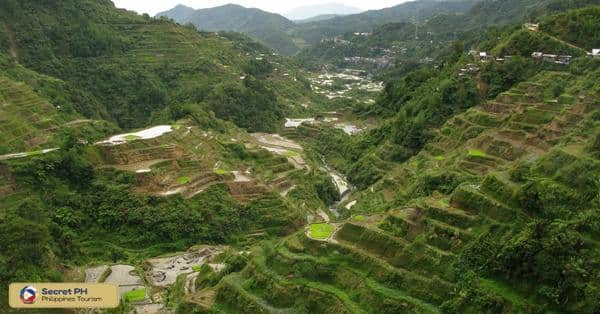Kalinga Province in the Philippines is a captivating destination known for its Tinglayan Rice Terraces and Tuga Catholic Church, blending natural beauty with cultural charm. The Aciga Tree, General Emilio Aguinaldo Historical Marker, and Sungang ViewPoint complete the province’s diverse attractions, making it an ideal place for those seeking a harmonious blend of stunning landscapes and historical landmarks.
In this blog, we’ll take a closer look at the top 5 must-visit sights and landmarks in Kalinga Province that will surely leave you in awe. So pack your bags and get ready to explore this enchanting province!

1. Tinglayan Rice Terraces
The Tinglayan Rice Terraces are a group of rice terraces located in the town of Tinglayan, Kalinga province, in the Cordillera region of the Philippines. They are not part of the more popular Ifugao Rice Terraces, but they are just as majestic.
The Tinglayan Rice Terraces are believed to have been built over 2,000 years ago by the Kalinga people. They are a testament to the ingenuity and engineering skills of the Kalinga people, who were able to create a sustainable agricultural system in the rugged mountains of the Cordillera.
The Tinglayan Rice Terraces are a popular tourist destination, and they are also a UNESCO World Heritage Site. Visitors can hike to the terraces and enjoy the views, or they can visit the local villages and learn about the Kalinga culture. Here are some of the most popular Tinglayan Rice Terraces:
Bugnay Rice Terraces: These terraces are located in the village of Bugnay, and they are some of the most scenic in Tinglayan. The terraces are best viewed from the Bugnay Viewpoint, which offers a panoramic view of the terraces and the surrounding mountains.
For directions, click here.
Buscalan Rice Terraces: These terraces are located in the village of Buscalan, and they are home to the famous mambabatok, or traditional tattoo artist, Apo Whang Od. The Buscalan Rice Terraces are also a popular hiking destination, and they offer stunning views of the surrounding mountains.
For directions, click here.
Luplupa Rice Terraces: These terraces are located in the village of Luplupa, and they are some of the oldest rice terraces in Tinglayan. The Luplupa Rice Terraces are a good place to learn about the traditional Kalinga method of rice farming.
For directions, click here.

2. Tuga Catholic Church
The Tuga Catholic Church, also known as St. Joseph the Worker Parish Church, is a simple church located in the barangay of Tuga, Tabuk City, Kalinga province, in the Cordillera region of the Philippines. It is dedicated to Saint Joseph the Worker, the patron saint of farmers, fishermen, and other laborers.
The Tuga Catholic Church was built in the early 1900s by the Spanish missionaries. It is a small, whitewashed church with a simple façade. The church has a single bell tower and a tin roof.
The interior of the church is also simple. The main altar is made of wood and stone, and it is decorated with a statue of Saint Joseph the Worker. The church has several pews, and the walls are decorated with religious paintings and statues.
The Tuga Catholic Church is a popular pilgrimage site for Catholics in Kalinga. The church is also a popular tourist destination. Visitors can come to the church to pray, attend Mass, or simply admire the simple beauty of the church.
For directions, click here.

3. Aciga Tree
The Aciga Tree is a centuries-old acacia tree located in the barangay of Aciga, Pinukpuk, Kalinga province. It is one of the largest and oldest acacia trees in Kalinga. The Aciga Tree is a popular tourist destination, and it is also a sacred place for the Kalinga people. The Kalinga people believe that the tree is home to spirits, and they often come to the tree to pray and offer sacrifices.
The Aciga Tree is a large tree with a thick trunk and spreading branches. The tree is covered in green leaves and flowers, and it provides shade for the people who come to visit it. There are many legends and stories about the Aciga Tree. One legend says that the tree was planted by Kabunyan, the Kalinga god. Another legend says that the tree is a resting place for the souls of the dead.
The Aciga Tree is a symbol of the Kalinga people’s culture and heritage. It is also a reminder of the importance of nature and the environment. Here are some of the things that visitors can do at the Aciga Tree:
Take photos: The Aciga Tree is a beautiful and scenic place to take photos. Visitors can take photos of the tree’s trunk, branches, leaves, and flowers.
Learn about the history of the tree: The Aciga Tree has a long and interesting history. Visitors can learn about the tree’s history by talking to the local residents or by reading the information signs that are posted around the tree.
Enjoy the shade: The Aciga Tree provides shade for the people who come to visit it. Visitors can enjoy the shade of the tree and relax for a while.

4. General Emilio Aguinaldo Historical Marker
The General Emilio Aguinaldo Historical Marker in Lubuagan, Kalinga is a historical landmark that commemorates the time when General Emilio Aguinaldo, the first president of the Philippines, established his headquarters in the town from March 6 to May 17, 1900.
This marker was erected by the National Historical Commission of the Philippines on September 2, 1995. The marker is a popular tourist destination in Lubuagan. It is a place where visitors can learn about the town’s rich history and its role in the Philippine-American War.
In addition to its historical significance, the marker also offers stunning views of the surrounding countryside. On a clear day, visitors can see the Cordillera Mountains to the east and the Chico River Valley to the west.
The General Emilio Aguinaldo Historical Marker is a must-see for anyone visiting Lubuagan, Kalinga. It is a place where visitors can learn about the town’s rich history, appreciate its natural beauty, and pay their respects to one of the Philippines’ greatest heroes.
Address: 952F+FXR, Lubuagan, Kalinga
For directions, click here.

5. Sungang ViewPoint
Sungang ViewPoint is a popular tourist attraction in the municipality of Tinglayan, Kalinga. It is located in Barangay Maswa, about 7 kilometers from the town center. The viewpoint offers stunning views of the Tinglayan Rice Terraces, which are a UNESCO World Heritage Site.
The Tinglayan Rice Terraces are a series of terraced rice fields that have been carved into the mountains by the Kalinga people over centuries. The terraces are a testament to the Kalinga people’s ingenuity and their deep connection to the land.
Sungang ViewPoint is the best place to get a panoramic view of the Tinglayan Rice Terraces. From the viewpoint, you can see the terraces cascading down the mountainsides like a giant staircase. You can also see the Chico River winding its way through the valley below.
In addition to the Tinglayan Rice Terraces, Sungang ViewPoint also offers stunning views of the surrounding mountains and valleys. On a clear day, you can see as far as the Cordillera Mountains to the east. Sungang ViewPoint is a popular destination for photographers, hikers, and tourists alike. It is a great place to learn about the Kalinga people’s culture and to appreciate the beauty of the Philippine Cordillera mountains.

In conclusion
The Cordillera region of the Philippines is a treasure trove of natural and cultural wonders. From the majestic rice terraces to the centuries-old trees and historical landmarks, there is so much to discover in this region. The Tinglayan Rice Terraces, Tuga Catholic Church, Aciga Tree, General Emilio Aguinaldo Historical Marker, and Sungang ViewPoint are just some of the many must-visit destinations in Kalinga.
These places offer not only breathtaking views but also a deeper understanding of the region’s history and culture. So, whether you’re a nature lover, a history buff, or simply looking for an adventure, the Cordillera region has something to offer for everyone.








